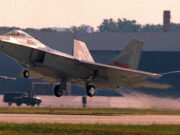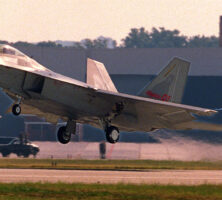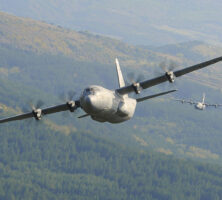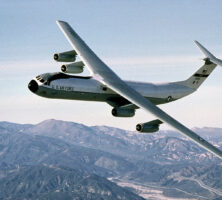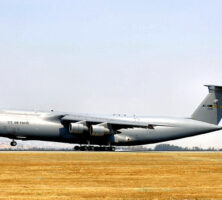Georgia’s aircraft industry has played a vital role in the nation’s defense and has been a central factor in the state’s economic resurgence since World War II (1941-45). The arrival of the Bell Aircraft Corporation to the state in 1942 began a long tradition of aviation activity in Georgia, which continues today with the Lockheed Martin Aeronautical Systems Company in Marietta.
Air Force Plant No. 6
The area’s largest aircraft manufacturing facility, Air Force Plant No. 6 in Marietta, was constructed in 1942-43 for the Bell Aircraft Corporation (also known as Bell Bomber) of Buffalo, New York. In this mammoth, 4.2 million-square-foot facility, Bell’s Georgia division built and delivered to the U.S. War Department some 663 Boeing-designed B-29 long-range bombers. After the war, the military canceled the B-29 contract, and Bell closed its operations in Georgia.
For the next five years the government used the huge B-1 assembly building merely to store surplus machine tools. However, the outbreak of the Korean conflict in 1950 created a new need for warplanes. In 1951 the Lockheed Corporation of Burbank, California, formally announced that it would reopen the plant. Unlike Bell, Lockheed stayed permanently in Marietta. By 1969 the workforce reached an all-time peak of 32,945 employees, and Lockheed had become the catalyst in the growth of modern Cobb County and the north Atlanta suburbs.
Lockheed and the C-130
The Lockheed Corporation traces its origins to 1913, when Allan and Malcolm Loughead (pronounced lock-heed) successfully piloted their garage-built seaplane across San Francisco Bay in California. During the Great Depression a Harvard University–educated entrepreneur, Robert E. Gross, and several associates bought the virtually bankrupt company and turned it into a major producer of commercial aircraft with the Model 10, 12, and 14 Electra series. During World War II the Model 14 Electra was refitted for military purposes as the Hudson Bomber. The corporation also worked collaboratively with rival manufacturers Boeing and Douglas in building the B-17 Flying Fortress. This record of cooperation helped to convince the air force that Lockheed was the ideal company to reopen the Marietta plant, as its initial tasks would be refurbishing B-29s and manufacturing Boeing-designed B-47s.
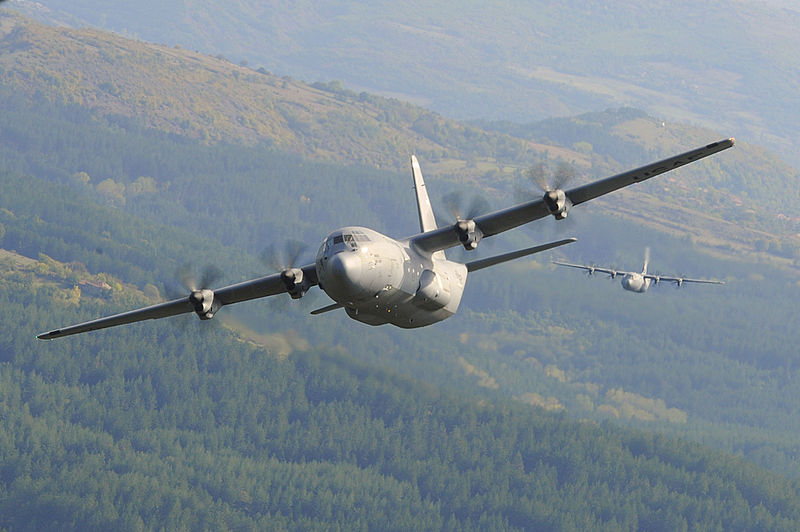
Photograph by Wikimedia
The first general manager of the Georgia division, James V. Carmichael, was chosen for his experience in running the old Bell Bomber operation and for his ties to the Atlanta and Cobb County business communities. While Carmichael would remain on the Lockheed board until his death in 1972, he soon turned over the operation to his assistant manager and successor, Daniel J. Haughton, an Alabama native who had risen into the top management of the corporation in Burbank. Haughton ran the Marietta plant from 1952 to 1956 and presided over the development of the C-130 Hercules, a modern transport plane that guaranteed the company’s continued presence in Georgia.
A remarkably serviceable aircraft, the C-130 is still being built, more than sixty years after the air force awarded Lockheed a contract to build the first two prototypes in 1951. The Pentagon wanted a medium-weight transport plane that could carry troops and equipment to the front and then take off again from short, dirt runways, even with the loss of an engine. The C-130 was initially engineered in California, but Dan Haughton lobbied Gross and the Lockheed board to assemble the plane in Marietta. In September 1952 the company agreed. Within a year the corporation moved project engineer Al Brown and his professional staff to Marietta. Thus, the production design work on the aircraft was completed in Georgia.
The C-141 and the Desegregation of Lockheed-Georgia
With the C-130 contract the Marietta facility was no longer merely a branch assembly plant, building planes designed elsewhere. The South now had its own complete manufacturer. Lockheed’s next transport plane, the C-141 Starlifter, was entirely designed and built in Georgia. In 1961 the administration of U.S. president John F. Kennedy announced an initial billion-dollar contract for 132 Starlifters, planes roughly twice the size of the C-130s.
In recognition of the plant’s growing importance, the corporate executives in Burbank reorganized the Georgia division as the Lockheed-Georgia Company. As the Marietta plant hired more and more engineers, the composition of the labor force changed dramatically. In the 1940s Bell’s Georgia branch had twenty-seven hourly workers for every one salaried employee. By the 1960s the ratio at Lockheed-Georgia dropped to 2.7 to 1.
The C-141 project was also significant for its role in desegregating one of the South’s largest employers. As soon as the contract was made public, the National Association for the Advancement of Colored People (NAACP) called for its cancellation on the grounds that Lockheed-Georgia discriminated against Black employees. While Lockheed operations in California were integrated, the Georgia facility conformed to southern traditions by maintaining segregated assembly lines, restrooms, water fountains, and lunchrooms. Despite a few modest efforts to hire Black workers, very few were in supervisory positions, and those few headed all-Black departments. The NAACP’s labor specialist, Herbert Hill, delivered thirty-one specific complaints to Kennedy’s newly created Committee on Equal Job Opportunities, chaired by vice president Lyndon Johnson. Eventually, the various parties achieved a desegregation agreement. On May 25, 1961, corporate executives met with President Kennedy at the White House to sign the nation’s first Plan for Progress between a major corporation and the federal government. In what Kennedy called a “milestone in the history of civil rights,” Lockheed-Georgia agreed to integrate assembly lines, recruit and train Black managers, and be a pilot plant in the South to test Kennedy’s equal opportunity policy. Three years before the Civil Rights Act of 1964, this agreement, involving one of Georgia’s largest employers, was significant in breaking down the Jim Crow culture of the southern workplace.
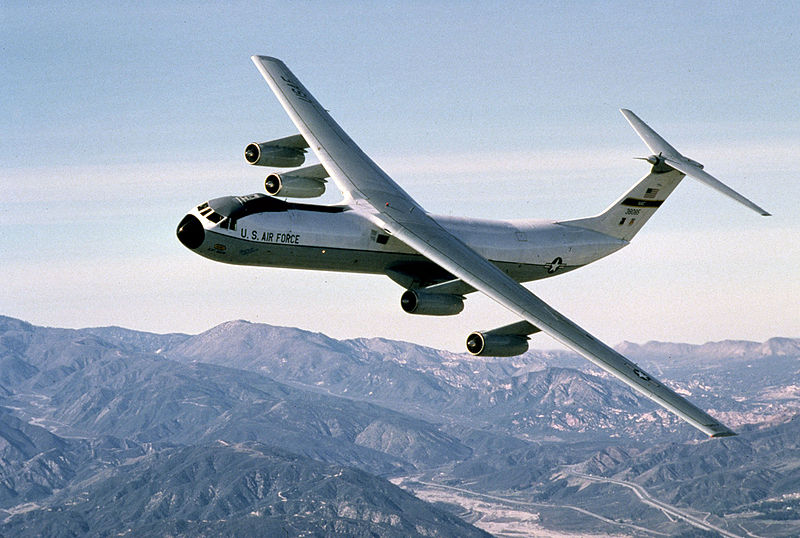
Photograph by Wikimedia
The C-5, Controversies, and Financial Difficulties
Lockheed-Georgia’s successes with the Hercules and Starlifter programs helped the company win another contract in 1965 for the biggest transport plane of the era, the C-5 Galaxy, which was nearly double the size of the C-141. The euphoria over this award, however, proved short-lived, as cost overruns, management errors, and Pentagon inflexibility made it impossible for the company to turn a profit. It soon became obvious that the bids by Lockheed and its competitors had all been ridiculously low, and the corporation was forced to renegotiate its contract with the Pentagon. In 1970 the government agreed to pay all planning and development costs minus $247 million. Rather than making money, Lockheed agreed to a quarter-billion-dollar loss. The plane itself turned out to be an engineering marvel, proving its value on battlefields in the Vietnam War (1964-73) and the Iraq War (2003-11).
Before Lockheed could recover from this debacle, it experienced another crisis in 1971 that almost drove it into receivership. The corporation had invested a considerable amount of money in its California-built passenger plane, the L-1011 Tri-Star, but the profit margin was always razor thin. Then its engine manufacturer, Rolls-Royce, filed for bankruptcy. Dan Haughton, by now the chairman of the corporate board, flew to England to help save the venerable British company. The English government agreed to take over ownership of Rolls-Royce, but only if Lockheed guaranteed the continued purchase of its engines. To keep the L-1011 program alive, Lockheed needed a sizable loan, which banks were reluctant to provide. Fortunately, Congress agreed that Lockheed was too vital to national interests to go under. In August 1971 U.S. president Richard Nixon signed into law the Emergency Loan Guarantee Act, providing assurance to private bankers that the United States would pay back the loan if Lockheed could not. In the end, everyone benefited. Lockheed received the loan it needed to buy Rolls-Royce engines and stay afloat. The British government assumed ownership of Rolls-Royce, which continued to play a major role in the aircraft industry. Lockheed retired its debts and eventually paid the American government a $31 million fee for insuring the loan. The deal cost taxpayers nothing and actually proved to be a moneymaker for the American people.
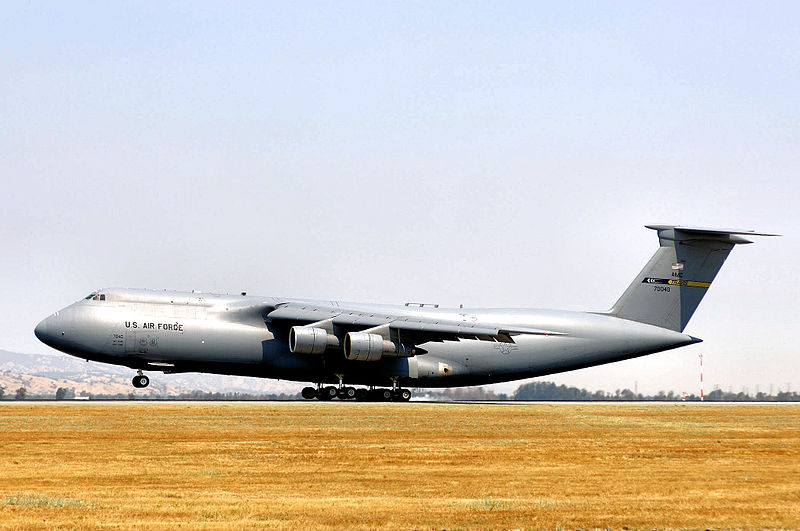
Photograph from the U.S. Air Force
Recovery and Merger into Lockheed Martin
Although Lockheed-Georgia survived these crises, its workforce would never be as large again. From almost 33,000 in 1969, it dropped to 8,400 by the end of 1977. Through these challenging years, the Pentagon’s continued purchases of C-130s provided a measure of stability. During the presidency of Robert B. Ormsby (1975-84) the company also received two important contracts for upgrades of its other transport planes. In 1978 the air force asked the Marietta plant to “stretch” the entire fleet of C-141s by some twenty-three feet and to add an aerial refueling system. Four years later Lockheed-Georgia won a contract to build fifty slightly larger, more powerful C-5Bs. By 1989, when the last of these Galaxies was delivered to the air force, the company was clearly back on its feet.
The end of the cold war presented Lockheed with a new set of challenges. In the early 1990s U.S. president George H. W. Bush ordered a cutback in defense spending. The Pentagon told defense contractors that they should begin to consolidate, as there was not enough business for everybody. In California, Lockheed chief executive officer Daniel M. Tellep had already begun a major reorganization, closing the historic Burbank plant and centralizing aircraft manufacturing in Marietta, where Kenneth W. Cannestra presided over a new Lockheed Aeronautical Systems Group. Meanwhile, Lockheed’s California operation focused on space and missiles. In 1993 Lockheed purchased General Dynamics’ tactical military aircraft operation, with headquarters in Fort Worth, Texas, where the F-16 fighter plane was manufactured. General Dynamics was already teamed with Lockheed and Boeing in developing the F-22 Raptor.
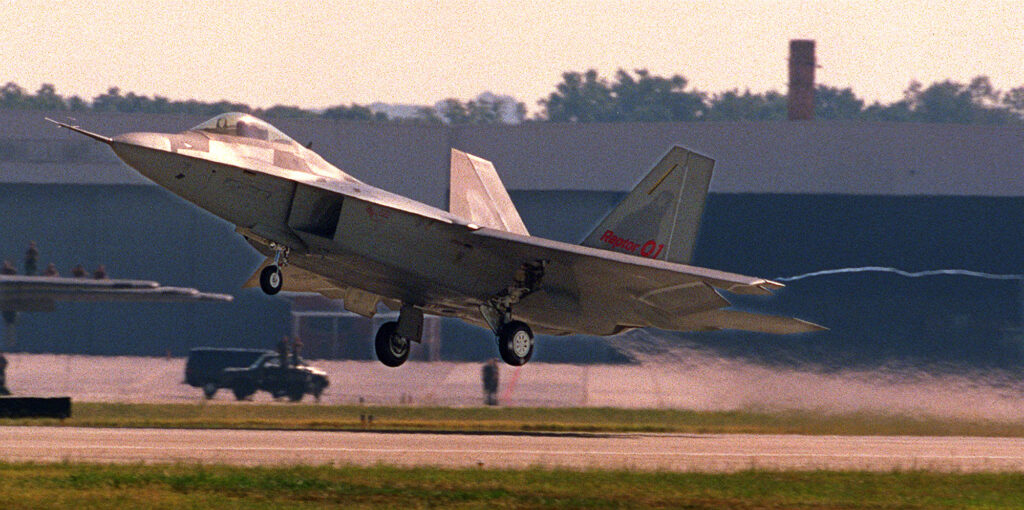
Courtesy of Atlanta Journal-Constitution.
Shortly afterward, Tellep initiated negotiations with Martin Marietta, another venerable company that traced its roots back to aviation pioneer Glenn Martin. By the 1990s Lockheed, America’s second-largest defense contractor, and Martin Marietta, the nation’s third-largest, were similar in size. Unlike Lockheed, however, Martin Marietta had abandoned aircraft manufacturing, choosing instead to focus on aerospace engineering and missile technology. In March 1995 stockholders of the two companies approved a $10 billion merger, creating the Lockheed Martin Corporation, with headquarters in Bethesda, Maryland. The Georgia operation was renamed Lockheed Martin Aeronautical Systems Company (LMASC).
In 2000 Lee E. Rhyant, a Georgia native and the first African American to head the Marietta plant, became the general manager of LMASC. In the early twenty-first century the facility was able to stay in business through Pentagon contracts for C-130Js and F-22 fighter planes. It also had a contract to modernize all 111 of the air force’s C-5 fleet. In 2005 the workforce stood at 7,800, and on May 16, 2006, the company held a ceremony in Marietta to display the first of the C-5M Super Galaxies.


